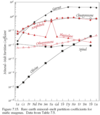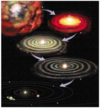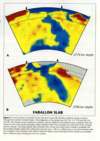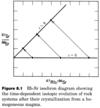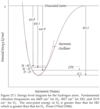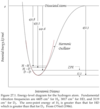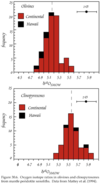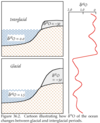geochemistry Flashcards
(212 cards)
what does HFSE stand for?
why does it have this name?
high field strength elements
they get their names from the high charge and small ionic radius thus high field strength
are HFSE compatible or incompatible during mantle melting? why?
incompatible
because its hard for them to change with 2+ charged ions
what are the four main HFSE? which are moderaltely incompatible and which are highly incompatible?
Zr4+ (zirconium) - moderatley
Hf4+ (hafnium) - moderately
Nb5+ (niobium) - highly
Ta5+ (tantalum)- highly
by mass what are the ratios of mantle core and crust?
mantle ~2/3
core ~ 1/3
around what percentage are trace elements in common rocks?
trace elements <0.1%
what can and cant trace elements do?
trace elements can substiute for major elements in minerals but they are not themselves essential structral constituents
in terms of mass what does 1ppm and 1ppb equal?
1ppm = 1 microgram of element per gram of rock
1ppb = 1 nano gram of element per gram of rock
what are the major elements in silicate rocks?
O
Si
Al
Na
Mg
Ca
Fe
what are is the percentage range of minor elements?
present at concentration of 0.1% to 1%
what element can behave like a major and trace element?
potassium does not form its own mineral in MORB or mantle thus K is a trace element in the ocean crust and mantle
K is a major element in granites and continental crust where it forms K feldspars
what is meant by lithophile elements?
lithophile elements
are rock-loving, as they like to partition into
silicate phases. They are concentrated in the silicate portions of the
Earth (the crust & mantle).
what is meant by siderophile elements?
Siderophile elements
are metal-loving, as they partition into
metallic liquids. They are strongly enriched in the core but depleted in the silicate Earth.
what is meant by chalcophile elements?
Chalcophile elements
are sulfur-loving and they partition into
sulfide liquids.
what is meant by atmophile elements?
Atmophile elements
are generally highly volatile, which means that
they like to form gases or liquids at the Earth’s surface. They are
concentrated in the atmosphere and the hydrosphere.
what causes the goldschmidts classification?
differenes in chemical and physical properties of the elements.
elements with low electronegativity have a tendency to form ionic bonds with elements of high electronegativity. thus they form oxides and silicate minerals so are lithophile.
The siderophile and chalcophile elements have intermediate
electronegativities and they prefer covalent bonds (as those in
sulfides) and metallic bonding (which both feature sharing of
electrons) to ionic bonds.
The noble gases are very unreactive and they do not form bonds.
Thus concentrated in the atmosphere.
chalcophile does not automatically imply that an element is found in sulfide ore deposits. what does it mean then?
Many sulfide deposits are precipitated
from aqueous solutions but chalcophile means that an element
partitions into magmatic sulfide liquids/phases.
what does HSE stand for? how do they behave in the mantle?
HSE - highly siderophile elements
the HSE behave as chalcophile elements in the mantle
the partitioning of trace elements into minerals is primarily a function of…
the partitioning of trace elements into minerals is primarily a function of ionic charge and radius
The ions of one element can extensively replace those of
another element in ionic crystals (such as silicates) if…
The ions of one element can extensively replace those of
another element in ionic crystals (such as silicates) if their
radii differ by less than ~15%.
how can ions whose charges differ by one substiute for each other?
Ions whose charges differ by one unit substitute readily for
one another, provided electrical neutrality can be maintained
in the crystal.
charge neutrality is maintained by the coupled
substitution of Al3+ for Si4+.
When two different ions occupy a particular position in a
crystal lattice, the ion with … forms a stronger bond with the anions surrounding the site.
When two different ions occupy a particular position in a
crystal lattice, the ion with the higher ionic potential ( = higher
charge/radius ratio) forms a stronger bond with the anions
surrounding the site.
thus the ion with the higher ionic potential is preferred to be substiuted.
Substitution may be limited, even when the size and charge
criteria are satisfied, when the competing ions have different…
Substitution may be limited, even when the size and charge
criteria are satisfied, when the competing ions have different
electronegativities and when they form bonds of different
ionic character.
what is the camouflage principle?
The Camouflage Principle applies where two ions have virtually
identical charge, ionic radii, and electronegativity.
when a mineral accepts two minerals as readily as the other due to being so similar. for example zircon (ZrSiO4) accepts Zr4+ and Hf4+ as much as the other.
the Zr/Hf ratio is therefore similar for zircon crystals and the magmatic liquid from which the zircon crystallizes.
all rocks and mineral have nearly identical Zr/Hf ratios
what is meant by the capture principle?
The Capture Principle applies when a trace element is
preferentially incorporated into a mineral relative to a major ion
because the trace element has a higher ionic potential.


